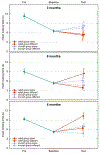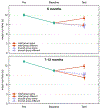Do infants discriminate non-linguistic vocal expressions of positive emotions?
- PMID: 27900919
- PMCID: PMC7537419
- DOI: 10.1080/02699931.2015.1108904
Do infants discriminate non-linguistic vocal expressions of positive emotions?
Abstract
Adults are highly proficient in understanding emotional signals from both facial and vocal cues, including when communicating across cultural boundaries. However, the developmental origin of this ability is poorly understood, and in particular, little is known about the ontogeny of differentiation of signals with the same valence. The studies reported here employed a habituation paradigm to test whether preverbal infants discriminate between non-linguistic vocal expressions of relief and triumph. Infants as young as 6 months who had habituated to relief or triumph showed significant discrimination of relief and triumph tokens at test (i.e. greater recovery to the unhabituated stimulus type), when exposed to tokens from a single individual (Study 1). Infants habituated to expressions from multiple individuals showed less consistent discrimination in that consistent discrimination was only found when infants were habituated to relief tokens (Study 2). Further, infants tested with tokens from individuals from different cultures showed dishabituation only when habituated to relief tokens and only at 10-12 months (Study 3). These findings suggest that discrimination between positive emotional expressions develops early and is modulated by learning. Further, infants' categorical representations of emotional expressions, like those of speech sounds, are influenced by speaker-specific information.
Keywords: Infant discrimination; cross-cultural differences; positive emotion; vocalisations.
Figures




References
-
- Blasi A, Mercure E, Lloyd-Fox S, Thomson A, Brammer M, Sauter DA, … Murphy DG. (2011). Early specialization for voice and emotion processing in the infant brain. Current Biology, 21(14), 1220–1224. - PubMed
-
- Bugental DE, Kaswan JW, Love LR, & Fox MN (1970). Child versus adult perception of evaluative messages in verbal, vocal and visual channels. Developmental Psychology, 2(3), 367–375.
-
- Fernald A (1993). Approval and disapproval: Infant responsiveness to vocal affect in familiar and unfamiliar languages. Child Development, 64(3), 657–674. - PubMed
-
- Grossman T (2010). The development of emotion perception in face and voice during infancy. Restorative Neurology and Neuroscience, 28, 219–236. - PubMed
MeSH terms
Grants and funding
LinkOut - more resources
Full Text Sources
Other Literature Sources
